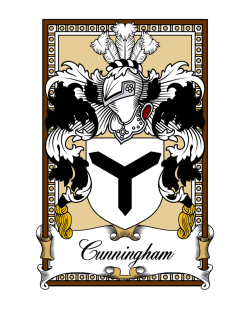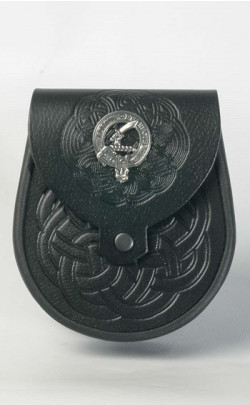
Clan Cunningham
OVER FORK OVER
The name Cunningham originates from a district in Ayrshire, and is thought to derive from the Gaelic word 'cuinneag', meaning 'milk pail' and the Saxon 'ham', meaning 'village'. The name is first noted in the 12th century. One popular story for the origins of the clan name states that an early clansman sheltered King Malcolm III under a pile of hay in a barn, and thus obtained the lands of Cunningham.
The Cunninghams were loyal to Robert the Bruce, and were rewarded generously after the Declaration of Arbroath was submitted in 1320. The name Cunningham is also widespread in Ireland, as Sir James Cunningham was five thousand acres of land in County Donegal in the early 17th century. Through marriage the clan inherited the lands of Glen Cairn and in 1488 the grandson of Sir William Cunningham was created first Earl of Glencairn.
The 14th Earl of Glencairn, James Cunningham, was a great friend and patron of Scottish poet Robert Burns. Burns wrote "Lament for James, Earl of Glencairn" following his death in 1791.
The Cunningham clan motto is "Over Fork Over" and the clan crest is a unicorn's head.
The Tartans
of Clan Cunningham
Scottish History
of Clan Cunningham
Repelling the invader
From a descent that can be traced back to those Anglo-Normans who settled in Scotland in the years following the Norman Conquest of England in 1066, the Cunninghams became main players over the succeeding centuries in the drama and romance that is Scotland’s story.
Hugo de Moreville, a descendant of Norman invaders who had intermarried with the Anglo Saxon nobility of England following the battle of Hastings, settled on lands granted to him in northern Ayrshire, on Scotland’s west coast.
His power and influence increased to the extent that he was appointed to the premier post of Constable of Scotland, and in 1162 he granted some of his lands to a loyal retainer and kinsman known as Wernebald.
It is likely that Wernebald served de Moreville as one of his fighting men, or warriors, and that the land known as Cunninghame, in Ayrshire, was granted to him as reward for valued military service.
Dropping his Anglo-Saxon name, Wernebald adopted the name of his lands, giving rise to the family of Cunninghame, or Cunningham.
The spelling ‘Cunninghame’ appears to have given way to the spelling without a final ‘e’ in the late 17th to early 18th century and, for the sake of clarity, this is the form adopted in this brief narrative history of the family.
Some sources claim that ‘Cunningham’ itself derives from ‘Cunedda’, king of an ancient Celtic tribe known as the Votadini, and that it means ‘courage in battle.’
‘Cunedda’ eventually became ‘Cyning’, then ‘Cunning’, while ‘ham’ signifies a hamlet or small village.
‘Cunning’ has also been taken to mean a coney, or rabbit, and it is perhaps significant that the heraldic arms of the Cunningham Earls of Glencairn feature two coneys.
An understandably rather less popular explanation of ‘Cunedda’ is that it derives from ‘Cinneidigh’, meaning grim-headed, or ugly.
Whatever the derivation of the name and its adoption by Wernebald, it became a name to be reckoned with throughout the course of Scotland’s turbulent history.
In 1263, Viking invasion threatened as the King of Scots, Alexander III, laid claim to the Hebrides. Warned that Alexander was prepared to wrest the islands from Norwegian control by force if necessary, King Hakon of Norway embarked with a mighty fleet from Bergen in July of that year.
His fierce band of sea raiders plundered and ravaged Kintyre, Bute, and Islay, before appearing off the west coast mainland township of Largs.
A storm blew many of the vessels onto the shore beneath the overhanging Cunningham hills on the night of September 30, and it was on top of these hills that the Scots king hastily assembled a force of militia that included Harvey Cunningham of Kilmaurs, a local land-holder.
A party of militia emerged from their high eminence the following morning and engaged in a skirmish with a band of Norsemen attempting to salvage precious cargo from their stricken vessels.
The Scots drove them back to their ships and returned that evening to gleefully loot the cargo.
Stung by the insult, King Hakon ordered a further attempt to retrieve the cargo the following day, October 1, resulting in what has become known as the Battle of Largs, but which in reality consisted of a series of disorganised skirmishes.
The Norsemen were driven back to their vessels, however, and King Hakon died a few weeks later in Kirkwall, Orkney.
The threat to Scotland’s western seaboard in general and invasion of the mainland in particular had been averted, and Alexander III confirmed Harvey Cunningham in his possession of the lands of Kilmaurs a year later in recognition of his bravery.
The battle is commemorated annually at Largs with the ceremonial burning of a Viking longboat.
Further grants of lands and honours were bestowed over the following centuries on the Cunninghams.
King Robert the Bruce gave Hugh Cunningham the lands of Lamburgton, in Ayrshire, in 1319 as reward for his military service at the battle of Bannockburn five years earlier, while he later acquired further lands at Stevenston, where he built Kerelaw Castle. Although in ruins, the castle today is a tourist attraction.
An important marriage was made in 1399 when Sir William Cunningham married a daughter of Sir Robert Danielston of that Ilk. This marriage to Sir Robert’s heiress brought lands at Finlaystone, at Langbank, in Renfrewshire, lands near Kilmarnock and Strathblane, and the estate of Glencairn, in Dumfriesshire.
It was from these Glencairn lands that the future earls took their name. Finlaystone, although recognised as the ancestral home of the Cunninghams, is now actually home to the present day MacMillan clan chief.
More lands were steadily acquired in Ayrshire, giving rise to the important Cunningham family branches of Craigends, Lainshaw, Bridgehouse, Caprington, Robertland, Auchinharvie, Milncraig, and Corsehill.
Lands were also acquired in both Lanarkshire and Midlothian, but these passed out of Cunningham ownership in the early decades of the 18th century.
The bonnie fighters
Alexander Cunningham, who was made Lord Kilmaurs in 1462, and created 1st Earl of Glencairn by James III in 1488, had only a few short weeks to enjoy his new title before being killed in June of the same year at the battle of Sauchieburn, south of Stirling, and approximately on the same site of the battle of Bannockburn.
The earl was among a group of Scottish nobles who remained loyal to James in his struggle against other nobles who rebelled against his unpopular rule.
The rebels even had the tacit support of the king’s own son, the future James IV.
The Earl of Glencairn was slain during the battle, while a mysterious stranger murdered James after being thrown from his horse while fleeing the battlefield. The monarch, ironically, had carried the sword of Robert the Bruce into battle.
The succeeding history of the Cunninghams in effect becomes a history of the exploits of the succeeding earls of Glencairn, who became known as ‘bonnie fighters’ not only because of their military prowess, but their zeal in defending their deeply held beliefs.
William, the 4th Earl of Glencairn, was among the Scots nobles captured after the disastrous battle of Solway Moss in November of 1542 and imprisoned for a time in England.
The battle had resulted after Henry VIII of England declared war on Scotland in response to his nephew James V’s dogged refusal to sever his religious allegiance to the Papacy and alliance with France in favour of a closer alliance with England.
James died at Falkland Palace only a few weeks after Solway Moss and a matter of days before the birth of his heir, the future Mary, Queen of Scots.
The earl was released from captivity by Henry as one of the “assured Scots”, with the understanding that he would support and press for Henry’s proposal for the future marriage of the infant Mary, Queen of Scots, to his young son and heir Prince Edward.
In January of 1544, however, the Earl of Glencairn entered into a contract with the earls of Lennox, Cassilis, and Angus, to give support to what was known as the national party in Scotland, which was opposed to English interference in Scottish affairs.
A staunch supporter of the Protestant Reformation and implacable foe of Mary, Queen of Scots, Alexander Cunningham, 5th Earl of Glencairn, had been opposed to her return to Scotland from France in August of 1561.
Known to posterity as ‘the good earl’, despite the fact that he was responsible for the wanton destruction of the royal chapel at Holyrood, he was a firm friend of the fiery father of the Scottish Reformation, John Knox, and supported his return to Scotland from exile in 1554.
Knox is understood to have preached under a yew tree at the Cunningham property of Finlaystone, and the tree stands there to this day.
The earl mustered and marched a force of 2,500 men to Perth, in 1559, after Knox had preached a sermon that proved to be the spark that lit the militant flame of the Reformation, while he also played a leading role in the defeat of the ill-starred Mary at the battle of Langside, near Glasgow, in May of 1568.
He had also been appointed a member of the commission of regency following Mary’s forced abdication in 1567.
James Cunningham, 7th Earl of Glencairn, was deeply involved in the numerous squabbles and battles that raged around who should have the care of James VI during his minority.
Along with the earls of Gowrie and Mar, the earl was instrumental in the infamous Ruthven Raid of August 22, 1581, when the 15-year-old James VI was snatched from the care of the Regent, Arran.
The 9th Earl of Glencairn, William Cunningham, appears to have lived through particularly challenging times.
A supporter of Charles I until the monarch met his grim end on the executioner’s block on Tower Hill, the earl’s title was forfeited to the Scottish parliament but later restored when he rallied to the cause of the Covenant, which recognised the primacy to God, rather than the notion of the divine right of the Stuart monarchs.
His nation’s independence came first, however, and following the Cromwellian invasion of Scotland in 1650 he lent his support to the cause of the exiled Charles II, embarking from 1653 until 1654 in what became known as Glencairn’s Expedition – an ill-fated attempt to oust the English garrisons in Scotland.
An able military commander, the earl proved unable, however, to handle some of the wild Highland clansman he managed to rally to his support.
During a banquet held at Dornoch, Glencairn became embroiled in a fierce dispute with Sir George Munro over the discipline of the Highland forces the earl had raised.
The convivial atmosphere of the banquet soon descended into that of a rather less than civilised brawl, with the earl and Sir George literally having to be pulled apart as they engaged in a duel to defend their respective honours.
The earl was later forced, in the face of superior odds, to surrender to the forces of the able Cromwellian commander, General Monk, at Dumbarton.
Taken to England as a prisoner he was later allowed to return to Scotland, but promptly thrown into prison on suspicion of plotting against Scottish interests.
His constantly changing fortunes took a turn for the better following the Restoration of Charles II in 1660, when the monarch appointed him a Privy Councillor and, later, High Chancellor of Scotland.
Family History Mini Book
We hope you enjoyed reading this excerpt from this mini book on the Scottish history of the Cunningham family.
You can buy the full book for only114 Clan Cunningham
Tartan Products
The Crests
of Clan Cunningham



































































